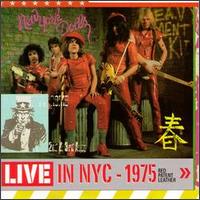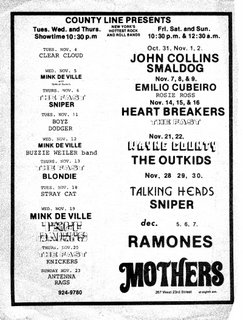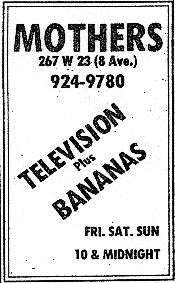LITTLE HIPPODROME--227 E. 56th Street, between 2nd & 3rd Avenues. This dinner theater/cabaret type of place is most notable as the site of the New York Dolls' final NYC shows, during their ill-advised (by Malcolm McLaren), Commie-inspired Red Patent Leather period in 1975. Nina Antonia explains it all in Too Much, Too Soon (London: Omnibus, 1998):
Malcolm...secured the band four dates between February 28 and March 2 at the Little Hippodrome. Situated on E. 56th Street, the theatre had a capacity of 2,000 and was more familiar with drag shows and stand-up comedy than rock groups, although the New York Dolls combined all three elements. The Little Hippodrome was out of the Dolls' usual venue circuit but that suited McLaren just fine, even if it proved a little disconcerting for their old fans...[Part of Malcolm's press release read], "The New York Dolls...have, in fact, assumed the role of the 'People's Information Collective' in direct association with the Red Guard. This incarnation entitled 'Red Patent Leather' will commence on Friday, February 28 at 10 p.m. continuing on Saturday at 9 and 11 p.m. followed by a Sunday matinee at 5 p.m. for our high school friends at the Little Hippodrome. This show is in co-ordination with the Dolls' very special 'entente cordiale' with the People's Republic of China."....Malcolm took the Communist Party image further by insisting that all tables in the Little Hippodrome should be draped in red fabric and even suggested that every drink sold while the Dolls were appearing should have an injection of red dye. The major theatrical gesture, aside from the band [attired in red outfits], was a huge red flag bearing the hammer and sickle which would be hung as a backdrop behind the group.
On the first weekend the opening act was Pure Hell, an all-black band. By the second show in the run, Jerry Nolan proved too drug-addled to perform, and Pure Hell's drummer Spider was asked to fill in. Arthur Kane was also undergoing some heavy drug problems at the time, managing to make it only to the final show; a bass player named Peter Jordan played the other shows in his stead. The following weekend, March 7-9, featured Television as the openers--their final shows with Richard Hell in the line-up. Wayne County DJed between the sets; David Jo had him intersperse his usual garage rock classics with tracks from a Communist Worker's Party album, much to Wayne's and the audience's chagrin.

Accounts vary widely as to how well, or how terribly, the Dolls went over on these dates.
From Too Much Too Soon: David Johansen clutched a copy of the Maoist handbook like a Bible and wondered who was going to be the next in line to fall. In the fact of adversity--in reality the only face they'd ever known--the Dolls performed as pluckily as ever. Unfortunately, the band didn't sound totally at ease with the new numbers and neither did the audience who lit up only when the Dolls broke into established favourites....Paul Nelson: "It was a disaster...It was very strange, you didn't know if it was supposed to be funny or not."...If McLaren had staged the Dolls' red uprising in Europe, the audience's sensibilities might not have been so ruffled, but 56,555 American soldiers had died in Vietnam attempting to stem a Communist take-over. It was too much of a sore point for most to understand the intended irony of the Dolls' attire.
In McNeil & McCain's Please Kill Me (New York: Grove, 1996) Jerry Nolan complains about the artsy-fartsy stupidity of the Red posturing. But in contrast, Clinton Heylin's From the Velvets to the Voidoids (New York: Penguin, 1993) has quotes from Nolan and Chris Stein attesting that these were among the greatest, tightest, and least erratic shows the band ever put on. Regardless of what actually went down at the Hippodrome, it wasn't long before a combination of less-than-stellar Florida gigs and over-the-top drug abuse led to the final dissolution of the Dolls. One of the Hippodrome shows was documented on a live album, Red Patent Leather--currently available as part of a two-disc set entitled Great Big Kiss.


Seems as if few other bands played at the Little Hippodrome--I've found references only for Orchestra Luna and the Steve Lyons Eyeshow. Not sure when the theater closed, but the site is currently occupied by a fancy old-school (but not Red) Chinese restaurant called Bill Hong's.


